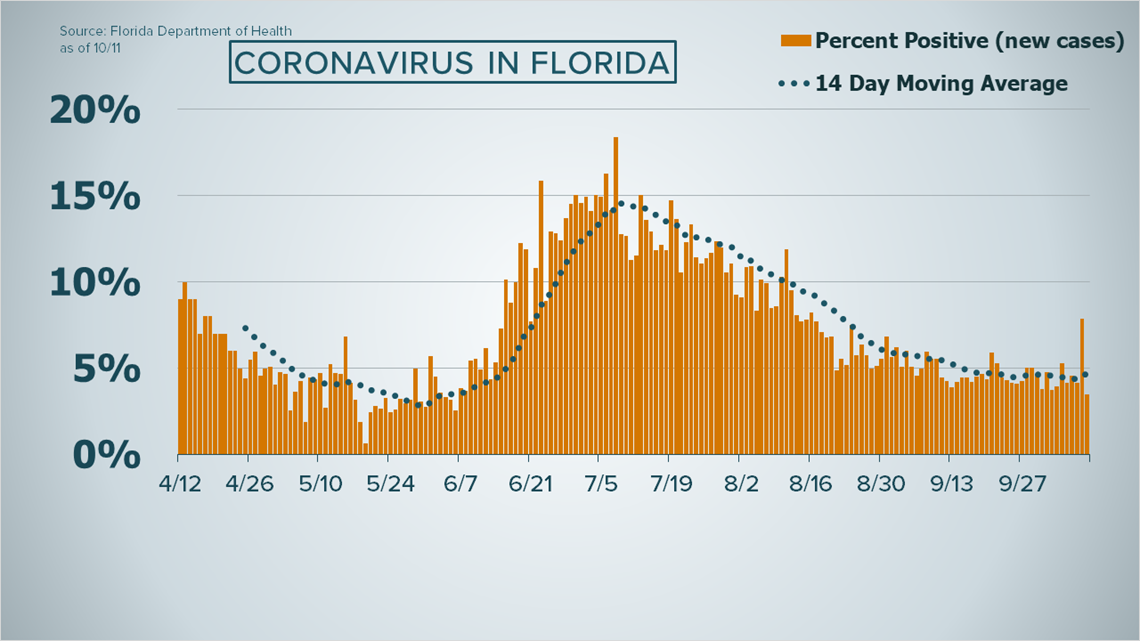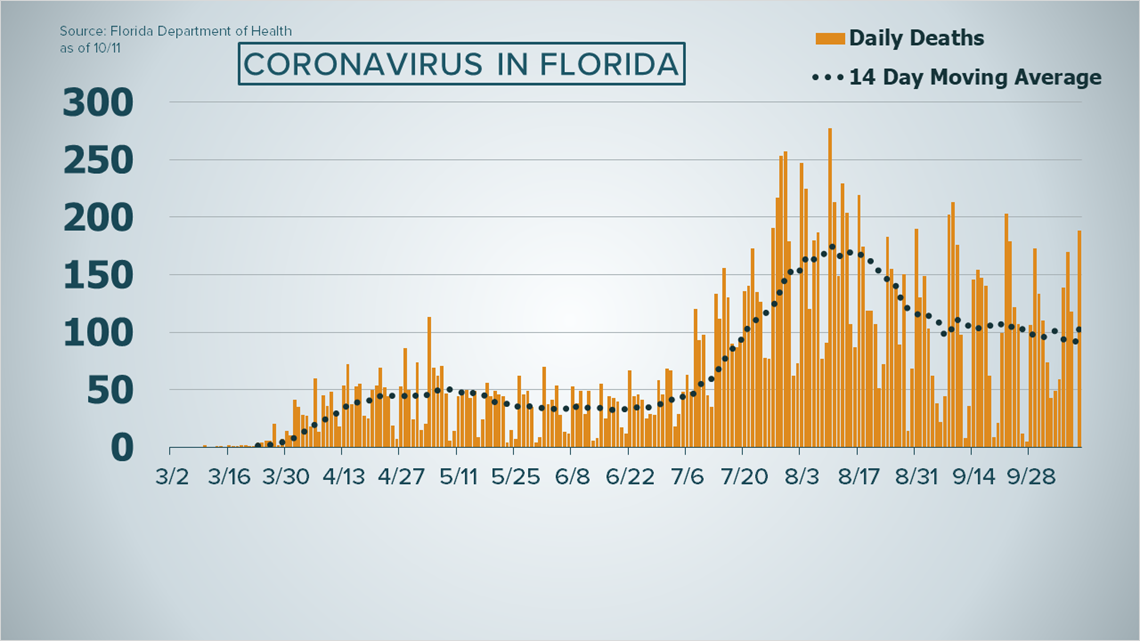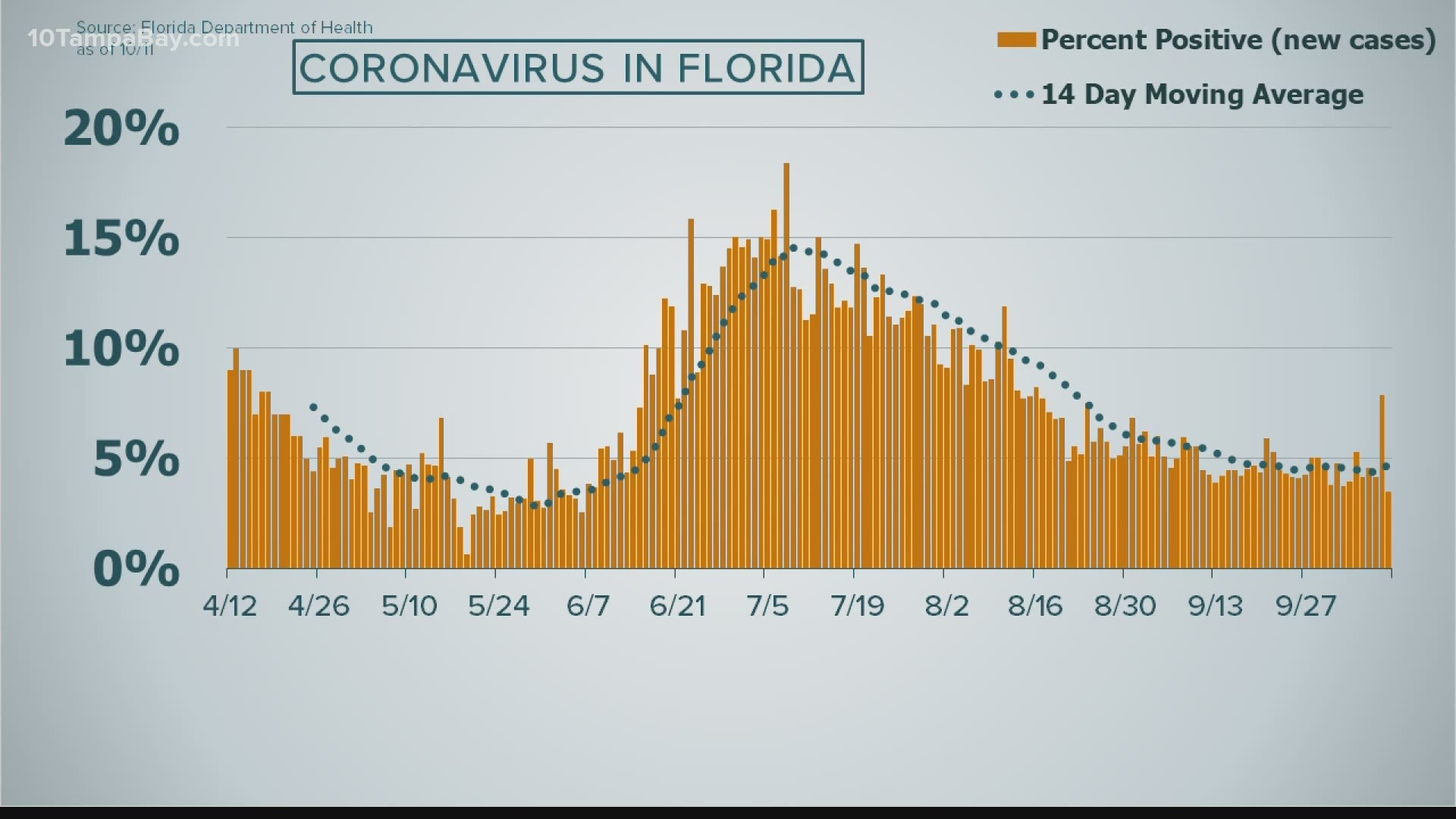ST. PETERSBURG, Fla. — The Florida Department of Health says there are 5,570 new cases of COVID-19 statewide through Oct. 10 in its latest Sunday report.
It comes a day after the state, for the first time since the coronavirus pandemic began, did not release a daily report. The agency on Saturday said a submission of 400,000 previously-reported coronavirus test results from Helix Laboratory, a private lab, forced a delay to sort through the numbers.
"The massive size of the data file and the need to de-duplicate hundreds of thousands of results prevented the Department of Health's automatic reporting system from processing yesterday's results as it normally does," the DOH said earlier.
The addition of 5,570 new cases brings the total to 734,491 coronavirus cases statewide since March. The latest new case figure was determined using data provided in the agency's Sunday report and subtracting what was listed in the Friday report. On Saturday, again, the state did not release a report because of a data dump error.
The statewide total since the pandemic began is presented on the Department of Health's state report and dashboard.
The health department also reported another 178 Floridians and two non-residents have died after testing positive for COVID-19. That brings the total to 15,364 Floridians and 188 non-residents who have died from the virus since the pandemic began. These figures were determined using the same method as finding the total number of cases.
Those numbers do not necessarily mean those people died Friday and Saturday but rather the state learned of their deaths and added the numbers to the report that day. The state's line-by-line report, which you can read here, lists coronavirus deaths by the date the people tested positive for the virus, not the date they passed.
The state says a total of 139,259 tests were returned from labs Oct. 9-10, with a two-day average of 4.24 percent positivity. According to the Department of Health, the percent positivity was 7.88 percent on Oct. 9 and 3.47 percent Oct. 10, but those numbers are best presented using the two-day average because of the error.
The median age of Floridians testing positive is 38.


The positivity rate is one piece of data health experts analyze to determine how well an area is doing in combating the coronavirus and conducting tests. The World Health Organization has repeatedly said the percent positive should remain at 5 percent or lower for a 14-day span in order for further reopening to be recommended.
For the past couple of weeks, Florida has reported percent positive rates at or below 5 percent.
A total of 45,924 people in Florida have been hospitalized with coronavirus at some point during the pandemic, with 519 of those hospitalizations being right here in the Tampa Bay area.
Here's a breakdown of new coronavirus cases reported to the state:
- June 21: 2,926
- June 22: 3,286
- June 23: 5,508
- June 24: 5,004
- June 25: 8,942
- June 26: 9,585
- June 27: 8,530
- June 28: 5,266
- June 29: 6,093
- June 30: 6,563
- July 1: 10,109
- July 2: 9,488
- July 3: 11,458
- July 4: 10,059
- July 5: 6,336
- July 6: 7,347
- July 7: 9,989
- July 8: 8,935
- July 9: 11,433
- July 10: 10,360
- July 11: 15,300
- July 12: 12,624
- July 13: 9,194
- July 14: 10,181
- July 15: 13,965
- July 16: 11,466
- July 17: 10,328
- July 18: 12,478
- July 19: 10,347
- July 20: 9,440
- July 21: 9,785
- July 22: 10,249
- July 23: 12,444
- July 24: 12,199
- July 25: 9,344
- July 26: 8,892
- July 27: 9,230
- July 28: 9,446
- July 29: 9,956
- July 30: 8,989
- July 31: 9,643
- August 1: 7,104
- August 2: 4,752
- August 3: 5,446
- August 4: 5,409
- August 5: 7,650
- August 6: 7,686
- August 7: 8,502
- August 8: 6,229
- August 9: 4,155
- August 10: 5,831
- August 11: 8,109
- August 12: 6,236
- August 13: 6,148
- August 14: 6,352
- August 15: 3,779
- August 16: 2,678
- August 17: 3,838
- August 18: 4,115
- August 19: 4,555
- August 20: 4,684
- August 21: 4,311
- August 22: 2,974
- August 23: 2,258
- August 24: 2,673
- August 25: 3,220
- August 26: 3,269
- August 27: 3,815
- August 28: 3,197
- August 29: 2,583
- August 30: 1,885
- August 31: 7,569 (Quest Diagnostics backlog)*
- September 1: 2,402
- September 2: 3,571
- September 3: 3,198
- September 4: 3,656
- September 5: 2,564
- September 6: 1,838
- September 7: 1,823
- September 8: 2,056
- September 9: 2,583
- September 10: 3,650
- September 11: 3,190
- September 12: 2,423
- September 13: 1,736
- September 14: 3,116
- September 15: 2,355
- September 16: 3,255
- September 17: 3,204
- September 18: 3,573
- September 19: 2,521
- September 20: 1,685
- September 21: 2,470
- September 22: 2,590
- September 23: 2,541
- September 24: 2,847
- September 25: 2,795
- September 26: 1,882
- September 27: 738
- September 28: 3,266
- September 29: 1,948
- September 30: 2,628
- October 1: 2,660
- October 2: 2,811
- October 3: 1,868
- October 4: 1,415
- October 5: 2,241
- October 6: 2,582
- October 7: 3,306
- October 8: 2,908
- October 9: No daily report due to a Helix Laboratory data dump error
- October 10: 5,570
Breaking down the numbers
For the month of August, daily reported COVID-19 cases in Florida remained under 10,000. And, for more than a week, daily new cases were under 4,000.
That changed with the report for Aug. 31. A backlog* of nearly 75,000 test results from Quest Diagnostics was added to that day's report, which resulted in 7,569 new cases reported. Failure to report those test results earlier, most of which were more than two weeks old, with some dating all the way back to April, caused the Department of Health to sever all ties with Quest, according to the state.
Data for Oct. 10 was not individually released given a submission of approximately 400,000 previously-reported coronavirus test results from Helix Laboratory. The state said it needed to de-duplicate hundreds of thousands of results, which would allow daily reports to resume Oct. 11.
Florida on Aug. 22 became the second state to cross the 600,000 reported COVID-19 cases mark. As of Oct. 9, California has had more than 845,000 cases. Texas has more than 807,000 cases, according to Johns Hopkins University & Medicine.
Since Sept. 1, daily reported COVID-19 cases have stayed below 4,000.
By Sept. 26, the United States passed 7 million coronavirus cases, the highest recorded number in the world, CBS News reported. Just about a month prior, on Aug. 31, the United States passed 6 million coronavirus cases, according to the Associated Press. That was a little more than three weeks after the country surpassed 5 million confirmed coronavirus cases on Aug. 9.
The highest single-day case number Florida has reported so far is 15,300 for July 11. The lowest single-day case number the state has reported since early June is 738 confirmed on Sept. 28.
Florida has not reported a single-day new case number at or higher than 10,000 since late July.
The state's report released on Aug. 11 of 277 newly confirmed deaths was the highest seen from the state in a single day's report.
The state recently added a section to its daily report (on page 5) that shows deaths by date of death. This data has been reported daily on Florida's COVID-19 dashboard. The graph for deaths by date of death is subject to change, though, because the information reported to the state can be delayed up to two weeks. So, for consistency, our charts have stuck to new deaths added by the date they were added. For transparency, you can always reference the state's data here.
The positivity rate is crucial for reopening. The World Health Organization has repeatedly said it must remain at 5 percent or lower for a 14-day span for the agency to recommend reopening.
However, it can be somewhat misleading: The number of people tested statewide varies each day, and the percent positives have ranged from a high of near 7 percent and a low of under 5 percent recently. Health officials say they would like to see a high -- but steady -- number of people tested every day and a suppressed percent positivity figure.
Until Aug. 21, Florida had not seen a positivity rate at 5 percent since the beginning of June. In July, the state reported positivity rates at double and even triple that recommended percentage.
The reports for Aug. 1 and 2, respectively, showed positivity rates below 10 percent for the first time since June 24. In August, the state reported a positivity rate above 10 percent five times.
The positivity rate reported for Oct. 3 (3.74 percent) is the lowest Florida has seen since early June.
On Friday, Sept. 25, Gov. Ron DeSantis announced the state could move into what was initially called "Phase 3" of its reopening plan. DeSantis signed an order guaranteeing restaurants the right to operate and lifting state-level capacity restrictions on them.


Hospitalizations and ICU bed availability
New cases have dropped significantly in recent months, but what about hospitalizations?
Tracking hospitalizations got easier on July 10 when the Agency for Health Care Administration began publishing a spreadsheet with the number of people currently checked-in for coronavirus-related complications in Florida. The data only includes people whose "primary diagnosis" was COVID-19.
As of Oct. 11, 2,105 people were hospitalized with COVID-19 as their primary diagnosis statewide, and 519 of them were in the Tampa Bay area. Those numbers are frequently updated, and you can click here for the most recent data, which is also broken down by county.
Since the pandemic began, the state confirms a total of 45,924 residents were hospitalized at some point during their illness.
The Agency for Healthcare Administration (AHCA) also updates total hospital bed and ICU availability by county.
Click here for a breakdown of adult and pediatric ICU bed availability by county. You can also check ICU availability by the hospital.
Hospitalizations around Tampa Bay and total staffed hospital bed capacity status:
**Data as of 11 a.m. Oct. 11, 2020.
Citrus:
- 10 COVID-19 hospitalizations
- 91 of 302 total staffed hospital beds are available
DeSoto:
- 2 COVID-19 hospitalization
- 41 of 55 total staffed hospital beds are available
Hardee:
- 0 COVID-19 hospitalizations
- 0 of 24 total staffed hospital beds are available
Hernando:
- 24 COVID-19 hospitalizations
- 247 of 724 total staffed hospital beds are available
Highlands:
- 23 COVID-19 hospitalizations
- 54 of 254 total staffed hospital beds are available
Hillsborough:
- 169 COVID-19 hospitalizations
- 837 of 4,071 total staffed hospital beds are available
Manatee:
- 29 COVID-19 hospitalizations
- 146 of 768 total staffed hospital beds are available
Pasco:
- 34 COVID-19 hospitalizations
- 270 of 1,324 total staffed hospital beds are available
Pinellas:
- 117 COVID-19 hospitalizations
- 1,251 of 3,617 total staffed hospital beds are available
Polk:
- 79 COVID-19 hospitalizations
- 488 of 1,762 total staffed hospital beds are available
Sarasota:
- 32 COVID-19 hospitalizations
- 271 of 1,193 total staffed hospital beds are available
►Breaking news and weather alerts: Get the free 10 Tampa Bay app
►Stay In the Know! Sign up now for the Brightside Blend Newsletter

